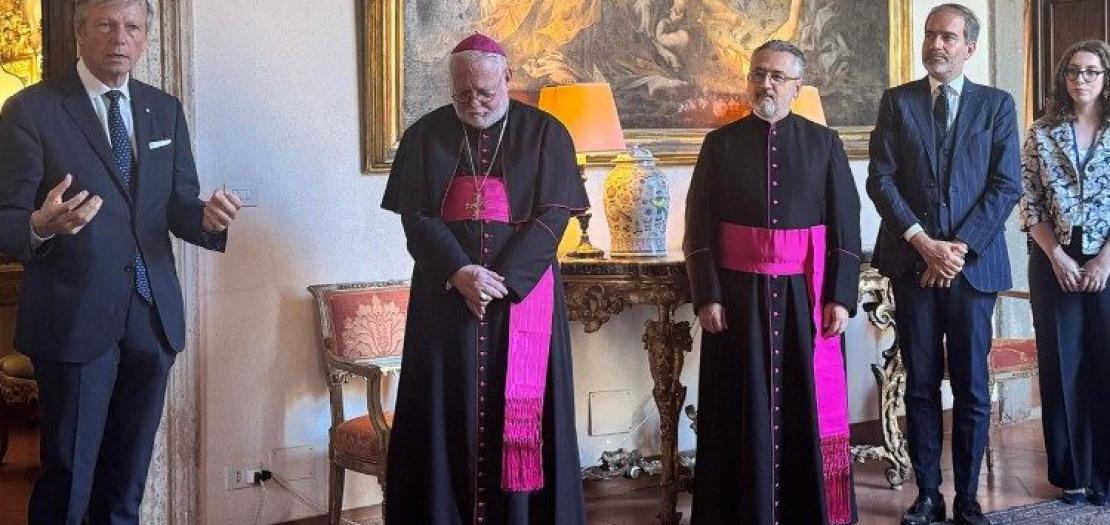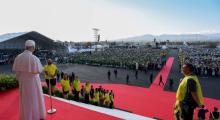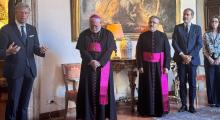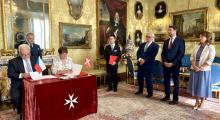Issued by the Catholic Center for Studies and Media - Jordan. Editor-in-chief Fr. Rif'at Bader - موقع أبونا abouna.org

In a quiet corner of the Roman countryside, an ambitious project is taking shape—one that seeks not only to power the Vatican City entirely through renewable energy, but also to embody the Catholic Church’s deepening ecological conscience. On July 31, at the historic Palazzo Borromeo, the Holy See and the Italian Republic signed a landmark agreement to build an agrivoltaic system in Santa Maria di Galeria. More than a technical feat, the initiative is a spiritual and diplomatic gesture—anchored in the conviction that caring for creation is a moral imperative.
The site of the future installation is no ordinary patch of land. Since 1957, it has hosted Vatican Radio’s shortwave transmission center, on extraterritorial land granted to the Holy See under agreements with the Italian government. On June 19, Pope Leo XIV visited the area, retracing the footsteps of Pope Pius XII and blessing not only the transmission towers but also the new frontier of the Church’s energy journey. The visit coincided with the anniversary of his priestly ordination—a symbolic convergence of personal vocation and ecclesial mission.
The agrivoltaic system to be built here is based on “Fratello Sole”, a motu proprio that Pope Leo XIV issued to promote environmental responsibility within Vatican infrastructure. The project aims to meet the full energy needs of both the Vatican State and Vatican Radio using solar technology integrated with agricultural activity. The vision is not of sterile solar farms, but of a harmonious blend of energy production and land stewardship.
According to the Vatican’s press office, the installation will apply the most advanced solutions currently available, balancing clean energy generation with the preservation of agricultural use, the region’s hydrogeological stability, and the protection of its cultural and archaeological heritage. The message is clear: ecological transition should not come at the expense of local history or community identity.
Archbishop Paul Richard Gallagher, the Vatican’s Secretary for Relations with States, signed the agreement alongside Italian Ambassador Francesco Di Nitto. In his remarks, Gallagher described the initiative as a «shared commitment to combating climate change,» noting that it honors both the 1992 UN Framework Convention on Climate Change and the 2015 Paris Agreement. But his words were more pastoral than political. Citing Pope Francis’s «Laudato Si’», Gallagher reminded listeners that access to clean, renewable energy remains elusive for many across the globe, and that while progress has been made, systemic change is still slow.
The agrivoltaic project is one of those “good practices” Pope Francis called for in his encyclical a decade ago. Yet it is also a fruit of the new pontificate. Pope Leo XIV, continuing and expanding the green path charted by his predecessor, has given the initiative fresh momentum. Last year, he tasked two major Vatican institutions—the APSA (which manages the Holy See’s assets) and the Governatorate of Vatican City—with turning the Santa Maria di Galeria land into a model of ecological transition.
That model is beginning to take form. APSA’s recently released 2024 financial report describes the agrivoltaic system not as a side project, but as a central pillar in its long-term strategy for sustainable development. For an office better known for managing real estate and stock portfolios, this marks a striking shift in focus—from preservation to transformation.
Dozens of Church and Italian state representatives witnessed the signing ceremony, including APSA President Archbishop Giordano Piccinotti and Sister Raffaella Petrini, Secretary General of the Governatorate. Their presence signaled that the project is not just symbolic, but institutional—a reflection of the Vatican’s intent to integrate environmental ethics into its very structures.
In his closing words, Archbishop Gallagher entrusted the agreement to the intercession of St. Ignatius of Loyola, whose feast the Church celebrates on July 31. He described the pact as an expression not only of mutual diplomatic respect, but of a deeper alliance: one that links ecology with peace, clean energy with human dignity, and faith with responsibility.
What’s unfolding in Santa Maria di Galeria is more than the installation of solar panels. It is a conversion—political, pastoral, and prophetic. It asks the Church, and the world, to imagine a future where the power that lights the Vatican’s basilicas comes not from fossil fuels, but from the sun that shines on its fields. A future where the Gospel is not only preached through words, but through the witness of action.







